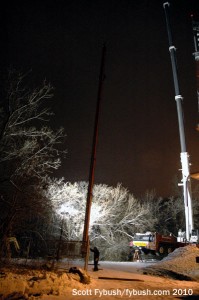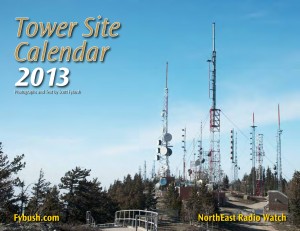NorthEast Radio Watch 12/8/2025: Cichon’s Back in Buffalo
In this week’s issue… Veteran newsman returns - Remembering NY's Leitner, RI's Jones - CT AM saved - Maine AM moves - "Indie" adds suburban signals
By SCOTT FYBUSH
Portions originally published January 14, 2011
So where were you two years ago this week? We were close to home one chilly night in early December 2010, watching a little bit of Rochester television history come down.
For 30 years, the most distinctive feature of Rochester’s venerable Pinnacle Hill TV/FM transmitter site was the tower at the middle of the cluster. Erected in 1979 by public broadcaster WXXI, the stick with its distinctive offset crossbar was home to the city’s two full-power UHF stations, WXXI-TV (Channel 21) and WUHF-TV (Channel 31), as well as WXXI-FM (91.5). WXXI-TV and WXXI-FM had been on the air from a different Pinnacle tower, the neighboring self-supporter that dates back to 1949 as the original home of WHAM-TV. (You can read more about the early history of Pinnacle Hill here and here.) The old WHAM-TV tower, eventually co-owned by WHAM-TV’s successor WROC-TV (Channel 8) and competitor WHEC-TV (Channel 10), was getting rather full by the late 1970s, and WXXI wanted to be able to top-mount its TV antenna, and so it came to pass that WXXI built this tower of its own on a little plot of land just across from WHEC’s transmitter building and next to the tower of WOKR (Channel 13, now WHAM-TV). WUHF’s debut in January 1980 filled the other side of the crossbar with a second UHF antenna, and in later years additional FM antennas were added down below.
And then came digital TV. WXXI lit up its new signal on RF 16 from a directional antenna mounted below the crossbar, on the opposite face of the tower from the WXXI-FM antenna, and WUHF built its digital signal on RF 28 at a completely different location, atop the new American Tower self-supporter up at the top of Pinnacle Hill, a short distance away from the main TV tower cluster. When WUHF turned off its analog signal in 2009, followed a month later by the end of WXXI’s nightlight analog operation, it was time to remove the heavy crossbar and UHF antennas from the top of the WXXI tower.
For whatever reason, it took more than a year before the unstacking finally happened, and by the time the night of December 5, 2010 came around, it was as bitterly cold and windy as a Rochester winter night can get.
Doing any kind of heavy work on the Pinnacle Hill towers generally has to be an overnight affair; with four full-power DTV stations transmitting from antennas located within just a few dozen feet of each other, tower crews can’t be atop one station’s tower without the others powering down.

When can that happen with minimal disruption to TV ratings and pledge drives? Two in the morning on a Sunday…a cold, windy, snowy one, as it turns out.
So it’s with great admiration (and even greater relief that it’s not us up there climbing the things), we settle in to watch the crews from Fred Nudd’s construction company begin dismantling the very tower they erected back in 1979. Nudd himself, still spry at 93, is on the scene when we pull up, guiding a crew that includes his grandson.
A few days before the shutdown, work began on assembling the massive crane that will rise 400 feet into the sky to bring the TV antennas (each of them about 70 feet tall) down to earth, and the first few hours of work tonight find one group of Nudd’s climbers ascending the tower to get into place for the antennas’ removal while another, smaller group sets about slowly raising the crane until it’s as tall as the towers here, which are dramatically lit from generator-driven lights down at ground level.
The first antenna to come down is the one that was used by WXXI-TV on channel 21 until the end of analog TV here. It was down from the tower once before, when a lightning hit a decade or so ago forced it to be rebuilt, so the crews figure it might be somewhat easier to unbolt than the WUHF (Channel 31) antenna, which hasn’t budged from its place since it was installed here just prior to WUHF’s debut in January 1980.
As it turns out, the WXXI antenna doesn’t come off without a fight (and help from a portable air compressor lifted up to the crossbar atop the tower by the crane!) It’s about 3 AM by the time the WXXI antenna finally comes loose, held up by a hook (attached by a tower climber who’s climbed up the antenna itself to grab the hook from the crane) and gently – not to mention very carefully – lowered to earth alongside the fence that surrounds the transmitter buildings.
The ground crew immediately sets to work on the antenna, inspecting the lightning damage it had suffered (some of the orange plastic radome material covering the antenna’s slots is scorched and twisted), removing the top beacon (it will be returned to the top of the tower) and beginning the laborious process of cutting up the antenna so it can be loaded atop a waiting flatbed trailer and hauled off for scrap in the morning. Meanwhile up on the tower, the climbers have hooked the remaining antenna to the crane and begun loosening its bolts.
It’s 4 AM by the time the WUHF antenna begins its stately swing down to the ground, and for the first time since the tower was built, it’s devoid of antennas up top – and the two UHF TV antennas are, very briefly, united in a line at ground level.
Even on a Sunday morning, the commercial stations are eager to get back on the air before dawn, so it’s becoming clear at this point that the dismantling of the tower’s top will have to be a multiple-night affair; the pedestals that supported the antennas and the big steel crossbar will come down another night, though there’s at least a brief attempt to get the pedestals removed before the climbers have to come down and the stations sign back on.
We drive away from Pinnacle Hill (and to a hot shower and some much-needed sleep) with an odd sight to greet us: no antennas atop that crossbar, leaving an odd-looking “T.” High winds and heavy snow prevent the rest of the work from taking place right away – indeed, an attempt the next day to get a wide shot of the newly-shorn tower is thwarted by blowing snow that makes it impossible to see the towers at all! The crews finally do get up there a few nights later, removing the crossbar in several pieces. (It was designed to come apart from the beginning, as it turns out.)
So why go to all this work in the middle of the winter, just to leave a bare-looking tower top with all of the remaining services on the tower (WXXI-FM 91.5, WXXI-TV’s digital signal on channel 16, WRUR-FM 88.5 and several translators) side-mounted below?
By removing the analog antennas and the crossbar, the tower could then support the considerable windload of a new FM antenna: a seven-around, one-bay ERI panel antenna that went up in early 2011, enabling a considerable power increase for WRUR, the signal owned by the University of Rochester and operated under a long-term contract by WXXI.
Two years after the analog antennas came down, more changes are on the way to the middle of Pinnacle Hill: WXXI-TV now has a construction permit to put a new top-mounted antenna on the tower, and whenever that new antenna goes up (possibly as soon as mid-2013), we’ll be there once again to document the changes.
 A dramatic night shot of the WXXI-TV antenna coming down is featured in the all new Tower Site Calendar 2013, shipping right now from the all new Fybush.com store! Order now and you can have your copy in hand by Christmas – why wait? (We’ve also got the very last FM Atlas copies available for sale, and the new edition of the National Radio Club’s AM Log.)
A dramatic night shot of the WXXI-TV antenna coming down is featured in the all new Tower Site Calendar 2013, shipping right now from the all new Fybush.com store! Order now and you can have your copy in hand by Christmas – why wait? (We’ve also got the very last FM Atlas copies available for sale, and the new edition of the National Radio Club’s AM Log.)
Want access to more than a dozen years’ worth of Tower Site of the Week? All our archives, fully searchable, are available to Fybush.com subscribers – and you get full access to NorthEast Radio Watch, too! Subscriptions start at just $15. Sign up here!
And don’t miss more IDs next Wednesday, over at our sister site, TopHour.com!
Next week: Previewing Tower Site Calendar 2013
In this week’s issue… Veteran newsman returns - Remembering NY's Leitner, RI's Jones - CT AM saved - Maine AM moves - "Indie" adds suburban signals
In this week’s issue… Scripps stations face takeover - Sinclair moves more affiliations - CT stations sold - Maine AM surrendered - Remembering WVBR's Shapiro, WABC's Morgan
In this week’s issue… CT TV legend succumbs to cancer - Remembering PA's Adams - FCC still stalled by shutdown - Pittsburgh morning host exits
In this week’s issue… FCC faces reopening challenges - Veteran Boston anchor retires - Morning shift in Toronto - NYC FMs expand reach